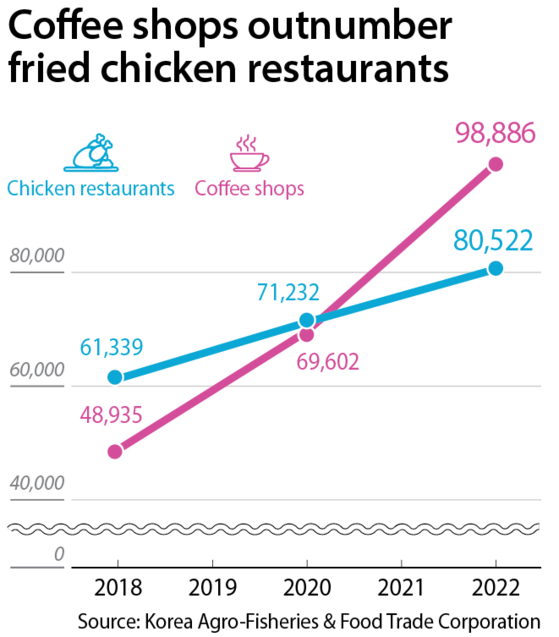Korea's coffee war pits shop against shop as prices plunge
![On the ground floor of an office building in Jung District, central Seoul, four coffee shops sit side-by-side. [YOO JI-YOEN]](https://koreajoongangdaily.joins.com/data/photo/2023/01/17/998d5094-9fe8-4413-97b1-c710f06b290b.jpg)
On the ground floor of an office building in Jung District, central Seoul, four coffee shops sit side-by-side. [YOO JI-YOEN]
Korea is a major battleground for smaller coffee chains.
Worthy of its self-proclaimed nickname “The Republic of Coffee,” Korea boasts a ubiquity of coffee shops, with nearly 100,000 cafes in a country only slightly smaller than the state of Kentucky.
In Jung District, central Seoul, one office building houses four coffee shops just on the ground floor.
“If the cafe next door sells things cheaper, I have no choice but to cut my prices,” an owner of one of the four coffee shops told the JoongAng Ilbo.
“An Americano, which was priced at 2,500 won ($2), was lowered to 1,300 won in about three years,” the coffee shop owner said. "I am getting through since I own the shop, but there are barley any margins left.”
This sort of “coffee war” — with multiple coffee shops competing against each other in one building — is no longer a surprise in Korea.
Nearly every alley has three to four coffee shops — from large coffeehouse chains like Starbucks and A Twosome Place and mid-priced local brands like Mega Coffee, Paik's Coffee and Ediya to individual shops in between.
According to the Korea Agro-Fisheries & Food Trade Corporation, there were nearly 99,000 cafes in Korea as of the end of 2022 — the highest number of coffee shops the country has ever seen. The number of cafes increased 21 percent in 2021 and 17.4 percent in 2022, outnumbering even the number of chicken restaurants operating — nearly 81,000, which remained one of the most popular self-owned businesses in Korea.

Coffee shop start-up consultancy Prong Coffee Design provides consulting services to an average of 10 coffee shop hopefuls per month.
“The younger generation often jump into the coffee industry thinking they have the capability, as many of them have experience working part-time at a cafe and it requires little capital,” said Choi Seon-wook, a director at Prong Coffee Design.
But as more people fall victim to the red ocean, coffee shops are competitively cutting prices to stay afloat.
Recently, a coffee franchise offering Americanos for 900 won — cheaper than the those sold at convenience stores — popped up, causing some shops to shutter.
Jin Sang-heon, 40, who operated Cafe Ma in Gimpo, Gyeonggi, closed his coffee shop after six months in April 2022. His cafe started suffering after a popular, low-priced coffee franchise opened right across the street a month after he started his business.
Jin’s cafe started offering morning discounts to stay competitive, but soon after, yet another coffee shop opened across the street, ultimately leading him to close his business.
“I hardly sold more than 100,000 won a day,” Jin said. "I had a deficit averaging more than 1.5 million won a month.” Jin worked 12 hours a day, but was hardly able to make up for the start-up cost of 70 million won.
Hyeon Hyeok, CEO of Broaden Coffee, a coffee bean distributor to some 280 cafes, said, “These days, the coffee war is like cutting one's nose off to spite one's face, with one new shop shutting down two old ones,” advising against jumping into the business without thorough preparation.
According to Seoul Metropolitan’s statistics for operating coffee shops, 2,187 coffee shops in Seoul shut down in 2022 — with an average of six coffee shops closing every day. The number hit a record after the previous year’s 1,970.
Already, 63 coffee shops have closed shop since the start of the new year, as of Jan. 13.
Analysts say coffee shops can generally survive if they can pay off monthly rent with four days' worth of sales. For instance, if the rent is 1 million won each month, coffee shops should hope to see daily sales of around 300,000 won.
Other types of beverages, aside from Americano, are becoming less profitable as material costs for items such as dairy products are rising.
“Recently, the price of a 1-liter pack of cream rose from 6,000 won to 9,000 won, while a 1-liter carton of milk rose from 1,800 won to 2,000 won, making it more difficult to operate a coffee shop,” said the owner of a cafe near Seonjeongneung Station in Gangnam District, southern Seoul.
BY YOO JI-YOEN, SEO JI-EUN [seo.jieun1@joongang.co.kr]










with the Korea JoongAng Daily
To write comments, please log in to one of the accounts.
Standards Board Policy (0/250자)